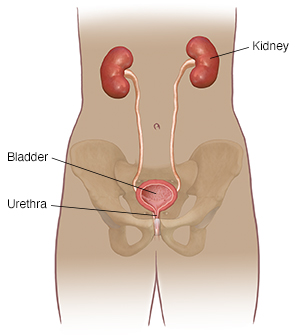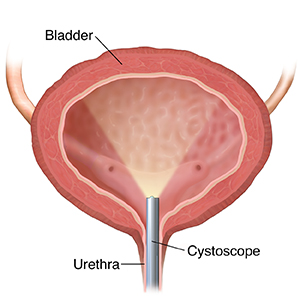Cystoscopy

Cystoscopy is a procedure that lets your healthcare provider look directly inside your urethra and bladder. It can be used to:
-
Help diagnose a problem with your urethra, bladder, or kidneys.
-
Take a small tissue sample (biopsy) of bladder or urethral tissue.
-
Treat certain problems (such as removing kidney stones).
-
Place a tube (stent) to bypass a blockage.
-
Take special X-rays of the kidneys.
Based on the findings, your provider may advise other tests or treatments.
What is a cystoscope?
A cystoscope is a telescope-like tube that contains lenses and small glass wires that make bright light (fiberoptics). The cystoscope may be straight and rigid. Or it may be flexible to bend around curves in the urethra. The healthcare provider may look directly into the cystoscope, or project the image onto a screen.

Getting ready
-
Ask your healthcare provider if you should stop taking any medicines before the procedure.
-
You will be asked to read and sign a form consenting to the surgery. Be sure to read the entire document. Have all of your questions answered before signing it.
-
Follow any directions you're given for not eating or drinking before the procedure.
-
Follow any other instructions your healthcare provider gives you.
Tell your healthcare provider before the exam if you:
-
Take any medicines, such as aspirin or blood thinners. This also includes any over-the-counter and prescription medicines, vitamins, herbs, and other supplements.
-
Have allergies to any medicines
-
Are pregnant or think you may be pregnant
During the procedure
Cystoscopy is usually done as an outpatient procedure in a surgery center or hospital. It is a fairly short procedure. But it may take longer if a biopsy, X-ray, or treatment needs to be done.
During the procedure:
-
You lie on an exam table on your back, knees bent and legs apart. You're covered with a drape.
-
Your urethra and the area around it are washed. Anesthetic jelly may be applied to numb the urethra. Other pain medicine is often not needed. In some cases, you may be offered a mild sedative to help you relax. If a more extensive procedure is to be done, such as a biopsy or kidney stone removal, general anesthesia may be given. This is to let you comfortably sleep during the procedure. Often a one-time antibiotic is given.
-
The cystoscope is inserted. A sterile fluid is put into the bladder to expand it. You may feel pressure from this fluid.
-
When the procedure is done, the cystoscope is removed.
After the procedure
If you had any type of sedation, general anesthesia, or spinal anesthesia, you must have someone drive you home. Once you’re home:
When to call your healthcare provider
Call your healthcare provider if you have any of these after the procedure:
-
Heavy bleeding or blood clots
-
Burning that lasts more than 1 day
-
Fever of 100.4° F ( 38°C ) or higher, or as directed by your provider
-
Trouble peeing
Online Medical Reviewer:
Marianne Fraser MSN RN
Online Medical Reviewer:
Raymond Kent Turley BSN MSN RN
Online Medical Reviewer:
Rita Sather RN
Date Last Reviewed:
10/1/2023
© 2000-2025 The StayWell Company, LLC. All rights reserved. This information is not intended as a substitute for professional medical care. Always follow your healthcare professional's instructions.